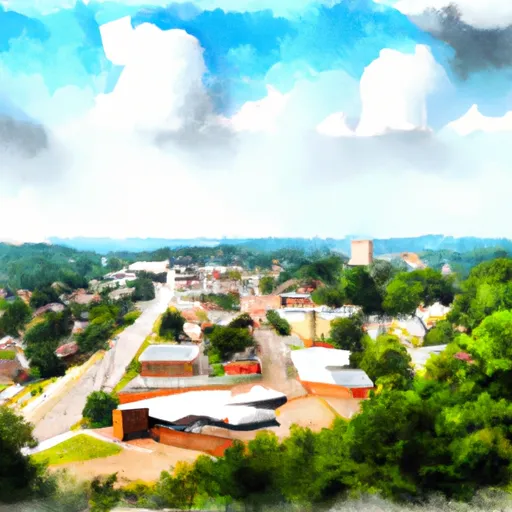-
 Snoflo Premium
Snoflo Premium
Get unlimited access to all our content
With no Ad interruptions! - Start Your Free Trial Login with existing account
Sharon
Eden Index
Climate
7.8
•
Recreation
1.1
•
Community
0.7
•
Safeguard
3.7/10

Sharon, Tennessee is a small town located in the northeastern corner of the state. It experiences a humid subtropical climate, characterized by hot, humid summers and mild winters. Average high temperatures in the summer months range from the upper 80s to low 90s Fahrenheit, while winter temperatures average in the 40s and 50s.
Hydrologically, Sharon lies within the Tennessee River watershed. The town is not directly on a major river or lake, but it is surrounded by smaller water bodies such as ponds, creeks, and streams. These water sources contribute to the overall hydrology of the area and provide opportunities for fishing, boating, and other water-related activities.
Outdoor recreation enthusiasts in Sharon have access to several options. The town is surrounded by picturesque countryside, making it ideal for activities such as hiking, camping, and wildlife viewing. Nearby state parks and natural areas offer additional opportunities for outdoor adventures, including bird-watching, picnicking, and nature walks. Additionally, anglers can enjoy fishing in the region's rivers, lakes, and ponds, where they can catch a variety of freshwater fish species. Overall, Sharon, Tennessee offers a pleasant climate, diverse hydrology constituents, and a range of outdoor recreation opportunities for visitors and residents alike.
What is the Eden Index?
The Snoflo Eden Index serves as a comprehensive rating system for regions, evaluating their desirability through a holistic assessment of climate health, outdoor recreation opportunities, and natural disaster risk, acknowledging the profound impact of these factors on livability and well-being.
Climate Health Indicator (CHI): 7.8
Sharon receives approximately
1342mm of rain per year,
with humidity levels near 84%
and air temperatures averaging around
15°C.
Sharon has a plant hardyness factor of
7, meaning
plants and agriculture in this region tend to thrive during the non-winter months.
By considering the ideal temperature range, reliable water supplies, clean air, and stable seasonal rain or snowpacks, the Climate Health Indicator (CHI) underscores the significance of a healthy climate as the foundation for quality living.
A healthy climate is paramount for ensuring a high quality of life and livability in a region, fostering both physical well-being and environmental harmony. This can be characterized by ideal temperatures, reliable access to water supplies, clean air, and consistent seasonal rain or snowpacks.
Weather Forecast
Streamflow Conditions
Hatchie-Obion
Area Rivers
Hatchie-Obion
Snowpack Depths
Hatchie-Obion
Reservoir Storage Capacity
Hatchie-Obion
Groundwater Levels
Recreational Opportunity Index (ROI): 1.1
The Recreational Opportunity Index (ROI) recognizes the value of outdoor recreational options, such as parks, hiking trails, camping sites, and fishing spots, while acknowledging that climate plays a pivotal role in ensuring the comfort and consistency of these experiences.
Access to outdoor recreational opportunities, encompassing activities such as parks, hiking, camping, and fishing, is crucial for overall well-being, and the climate plays a pivotal role in enabling and enhancing these experiences, ensuring that individuals can engage in nature-based activities comfortably and consistently.
Camping Areas
| Campground | Campsites | Reservations | Toilets | Showers | Elevation |
|---|---|---|---|---|---|
| Davis Bayou - Gulf Islands National Seashore | 52 | 19 ft | |||
| Fairley Bridge Landing | 6 | 88 ft | |||
| Gulf Marine State Park | None | 6 ft | |||
| Turkey Fork Rec. Area | 76 | 278 ft | |||
| Lake Perry | 20 | 157 ft | |||
| Keesler AFB Military | 52 | 22 ft | |||
| Maynor Creek Waterpark | None | 362 ft | |||
| Cypress Creek Landing | 17 | 103 ft | |||
| Shepard State Park | None | 16 ft | |||
| Janice Rec.Area | 7 | 116 ft |
Nearby Ski Areas
Catastrophe Safeguard Index (CSI):
The Catastrophe Safeguard Index (CSI) recognizes that natural disaster risk, encompassing floods, fires, hurricanes, and tornadoes, can drastically affect safety and the overall appeal of an area.
The level of natural disaster risk in a region significantly affects safety and the overall livability, with climate change amplifying these risks by potentially increasing the frequency and intensity of events like floods, fires, hurricanes, and tornadoes, thereby posing substantial challenges to community resilience and well-being.
Community Resilience Indicator (CRI): 0.7
The Community Resilience Indicator (CRI) recognizes that education, healthcare, and socioeconomics are crucial to the well-being of a region. The CRI acknowledges the profound impact of these elements on residents' overall quality of life. By evaluating educational resources, healthcare accessibility, and economic inclusivity, the index captures the essential aspects that contribute to a thriving community, fostering resident satisfaction, equity, and social cohesion.

